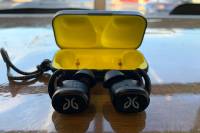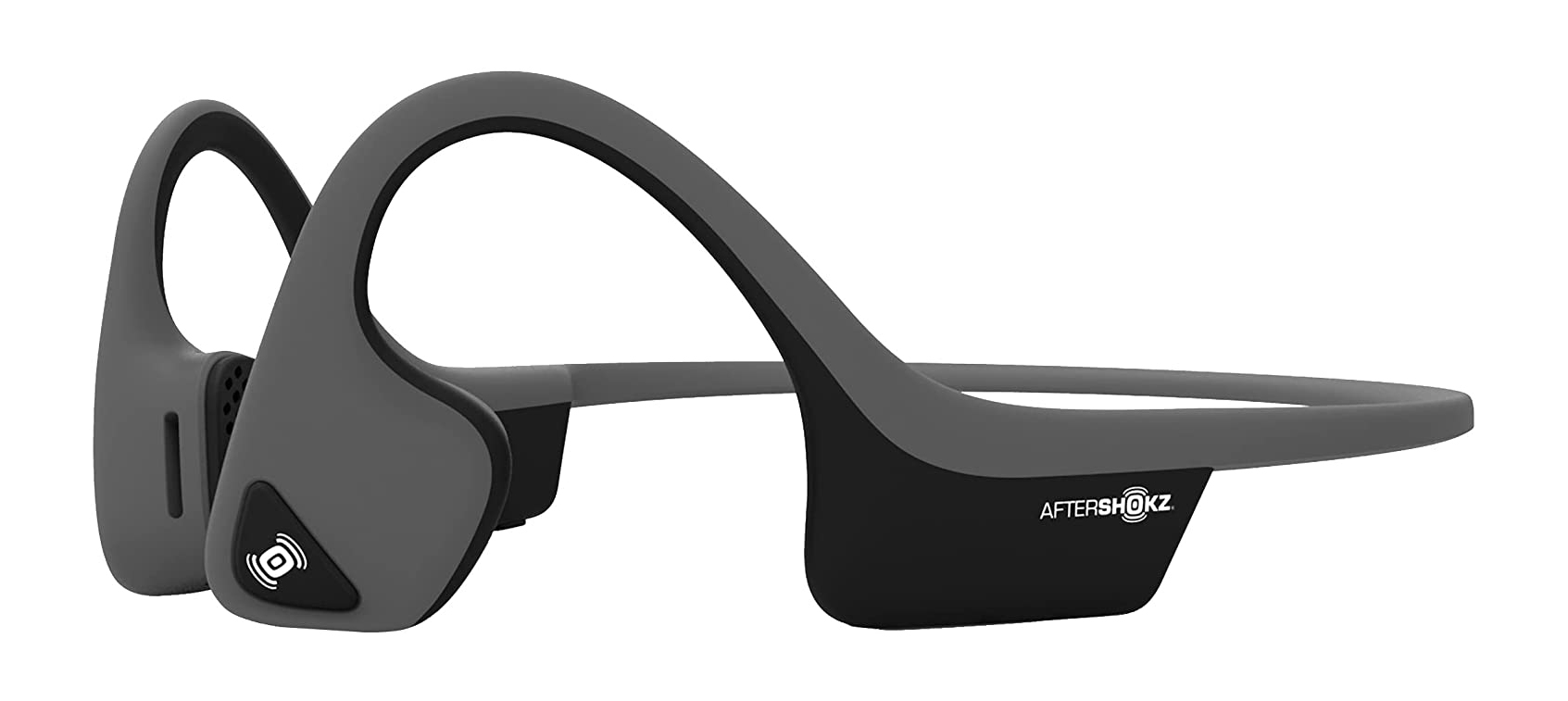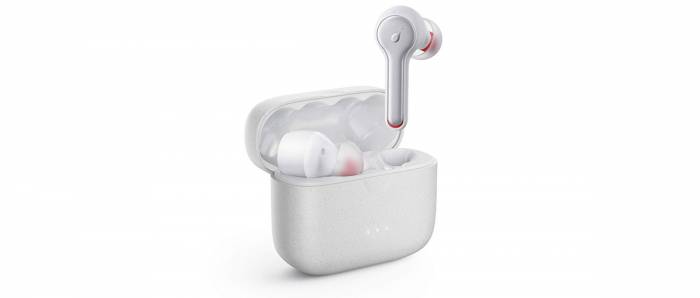The Best Workout Headphones of 2022
These earbuds and headphones will keep you humming at the gym or out on the trail.
Music and workouts go hand-in-hand. Taking the occasional break to listen to your body is great advice, but the bulk of runs and gym sessions use music to motivate or distract. And then there’s that ever-growing queue of podcasts to binge.
To find the best workout headphones and earbuds, we spent hours listening to music and podcasts during stationary workouts, road bike rides, and long runs. Sweat and the occasional icy drizzle were kept at bay by varying degrees of weatherproofing.
The industry has made great strides in this area, and any serious exercise earbud should offer waterproof ratings of IPX7 going forward, as they also keep out dirt and grime.
While there isn’t a single best earbud for every user, we’ve broken this list into categories to help you find the best headphones for your particular workout style. From wireless earbuds to budget-friendly headphones, there’s something for everyone.
Scroll through to see all of our recommended buys or jump to the category you’re looking for. At the end of our list, be sure to check out our comprehensive workout headphones buyer’s guide.
- Best Overall
- Runner-Up Best Overall
- Best Value
- Best Budget
- Best for Running
- Best Over-Ear
- Best for Situational Awareness
- Best of the Rest
The Best Workout Headphones & Earbuds of 2022
Best Overall: Under Armour Flash Wireless Earbuds
Different buds and fins mean you can dial the fit on these truly wireless earbuds and appreciate their full sound comfortably during workouts and runs. The 5-hour battery life and 20 hours of backup in the charging case put these earbuds ($170) at the forefront of longevity.
Hefty construction and waterproofing make these durable enough for all kinds of outdoor workouts. We had a couple of issues getting the Flash to quickly connect to Bluetooth when removed from the case, which is something we found other headphones did easily. But once connected, we didn’t lose signal.
We appreciated the rich sound and strong bass. And the volume was plenty loud, even in a noisy gym environment. It’s worth noting that some phones have a known issue of limiting volume via Bluetooth. If you’re initially unimpressed with the sound level, try connecting to your computer or another device to diagnose the problem.
Specs:
- Battery: 5 hrs. + 20 hrs. from case
- Weight: 16 g
Pros:
- Big battery
- Durability
- Rich bass
- Fit options
Cons:
- Initial connectivity issues; can feel bulky
Check Price at AmazonCheck Price at Under Armour
Runner-Up Best Overall: Jaybird Vista Truly Wireless Earbuds
The Jaybird Vista wireless earbuds ($150) quickly became a favorite with their rich sound. Runners will like that these can be activated separately to allow for running with just one earbud. Prolonged use revealed some shortcomings in comfort and sound due to a less-dialed fit.
As our editor noted during the full review, “At [MSRP], the Jaybird Vista falls on the steep end of the price spectrum for the category. But for that price, the brand offers up some impressive performance in terms of audio quality, fit, and software features.
“The Vista presents a great buy, but it does fall short of its big competitor, Apple AirPods, when it comes to the clarity and quality of the wearer’s voice on phone calls and video chats.”
Specs:
- Battery: 6 hrs. + 10 hrs. from case
- Weight: 12 g
Pros:
- Big battery
- Full sound
- Compact charge case
Cons:
- Fewer fit options
Check Price at AmazonCheck Price at Jaybird Sport
Best Value Workout Headphones: Jabra Elite Active 75t
The Jabra Elite Active 75t wireless earbuds ($180) hit the sweet spot of lightweight, well-fitting exercise earbuds that provide great sound during workouts without breaking the bank.
With more than 7 hours of playback, these earbuds provide immense bang for the buck. Though they aren’t the cheapest model on this list, their value is unmatched. Of the previously tested earbuds, only the Under Armour Flash earbuds can compete with the Elite Active 75t.
Another nice improvement is the quick-charging case, which can provide an hour of playback within 15 minutes. Like other models, these Jabra buds come with three sizes of grippy ear tips to fit in your ear. The charging case is sleek and lightweight (and less rounded than previous models).
We chose to test the Elite Active model over the Elite model because of its water resistance. These have an IP57 rating and reportedly can be submerged for 30 minutes. In our real-world testing, that meant they held up while caught out in the rain during a run. However, that doesn’t mean you can swim in them.
You can routinely find the Jabra Elite Active 75t on sale for $100, which gives you a lot of performance and function for far less than competitors. (Just note the designation between Elite Active and Active models.)
Specs:
- Battery: Up to 7.5 hrs., up to 28 hrs. with case
- Weight: 7 g
Pros:
- Plentiful battery life
- Lightweight
- Good value
Cons:
- Some users have encountered connectivity issues
Check Price at AmazonCheck Price at Jabra
Best Budget Workout Headphones: JBL Endurance RUN
These adjustable, wireless, in-ear buds ($20) can also be worn behind the ear when you need to be more aware of your surroundings. They’re sweat-resistant (IPX5) and have magnetic buds to keep them together while stored.
The fit was comfortable, and we didn’t have any problems with slippage. The sound isn’t as rich as some higher-end headphones, but for just 20 bucks, they’re a great value.
Specs:
-
Battery: 8 hrs.
- Weight: 11 g
Pros:
- Sweatproof
- Inexpensive
- Tangle-resistant
Cons:
- Floppy cord
Check Price at AmazonCheck Price at Walmart
Best Headphones for Running: Bose Sport Open Earbuds
Unlike most of the earbuds on this list, the Bose Sport Open Earbuds ($199) do not actually penetrate your ear canal. Instead, the earpiece sits on top of your ear in order to keep your ears open to the world for maximum safety and comfort while exercising.
If you plan to run or bike out in the world, these open earbuds are a great alternative to noise-canceling models. Of all the open-ear models on the market, the Bose Sport Open Earbuds offer superior sound quality and battery life.
Compared to standard in-ear headphones, open-ear models tend to rank lower in the bass department. Still, Bose has outfitted the Sport Open Earbuds with good clarity, natural-sounding mids, and just enough bass.
We feel these earbuds offer better sound quality than any of the bone conduction headphones on the market. In a sense, these are the perfect combination of sound quality and open-ear safety benefits. Runners and cyclists rejoice!
Specs:
-
Battery: Up to 8 hrs.
- Weight: 28 g (earbuds), 68 g (carrying case)
Pros:
- Good sound quality for an open-ear model
- Ideal for running
Cons:
- Not the best bass
- Somewhat expensive
Check Price at AmazonCheck Price at Bose
Best Over-Ear Headphones: Plantronics BackBeat Fit 500
Anyone who prefers over-ear Bluetooth headphones should consider the wireless Plantronics BackBeat Fit 500 ($34). We like that they’re sweat-resistant and easy to clean. We found them comfortable after hours of use. And they offer an impressive 18-hour battery life.
The sound wasn’t as rich as some of our favorite earbuds, but overall it’s decent (especially considering the price). Our main complaint is one we have with every over-ear headphone: movement. During rigorous workouts, the BackBeat is prone to slippage.
But these work great for lifting weights, walking, or circuit training around the gym.
Specs:
- Battery: 18 hrs.
- Weight: 155 g
Pros:
- Budget-friendly
- Sweatproof
Cons:
- Heavier
- Can shift during extreme workouts
Check Price at AmazonCheck Price at Walmart
Best for Situational Awareness: AfterShokz Air
These bone-conducting headphones ($120) are a comfortable and safe option for outdoor pursuits. Instead of filling the ears with sound, they rest on the bone in front of the ear and conduct sound via vibration. It seems crazy, but it works. It allows for full enjoyment of music or podcasts while still being aware of what’s happening on the trail or when biking or running around town.
We were able to comfortably wear the AfterShokz Air with glasses and a helmet. And at just a little over one ounce, they were light and easy to wear for long rides. The only time we noticed any vibration was at full volume.
And because they don’t fill the ear, they aren’t noise-canceling. But you can pair them with earplugs to achieve full noise cancellation.
Specs:
- Battery: 6 hrs.
- Weight: 30 g
Pros:
- Easy fit
- Situational awareness
- Ambient sounds
Cons:
- OK sound
- Vibrations at high volume
Check Price at BackcountryCheck Price at Amazon
Best of the Rest
Jabra Elite Active 65t
The Elite Active 65t ($100) are proven earbuds that have come down in price. These lightweight, truly wireless earbuds connect out of the case and automatically pause the sound when removed from the ear. We also like that the volume is easily adjusted on the side of the left earbud.
The sound was solid — but not as good as our top picks. Our big complaint was that their midrange sound felt constrained and often tinny.
These are designed to fit farther in the ear and only use gels to secure a fit in the ear canal. While this is comfortable, it can leave them feeling less secure during vigorous workouts, though they never fell out during test runs.
Specs:
-
Battery: 5 hrs. + 15 hrs. from case
- Weight: 6 g each
Pros:
- Lightweight
- Four microphones for voice calls
Cons:
- Tinny midrange
Check Price at AmazonCheck Price at Walmart
Apple AirPod Pro
The Pro version ($249) of Apple’s wireless earbuds finally comes with different-size silicone tips to seal the ear canal and ensure getting the most of the active noise-canceling qualities that adjust what you hear by monitoring surrounding sounds.
For workouts, transparency mode will help you keep aware of your environment. It’s worth noting, though, that these are only sweatproof (IPX4). At $249 MSRP, you’d better hope you never get stuck in the rain — and that Apple has fixed the issues with the long-term life of its earbuds.
Specs:
- Battery: 4.5 hrs. + 24 hrs. with wireless case
- Weight: 5.4 g
Pros:
- Adjustable fit
- Great sound
- Noise cancellation
- Headset features
Cons:
- Pricey
- Questionable long-term battery life
Check Price at AmazonCheck Price at Apple
Anker Soundcore Liberty Air 2
The Anker Soundcore Liberty Air 2 earbuds are a great value for truly wireless, sweatproof earbuds ($50). Plus, they boast an impressive battery life.
There can be frustrating issues with connecting both earbuds to Bluetooth. And the sound quality lags in comparison to other earbuds in the category. While these are decent earbuds, we’d generally spend a little more or search for better models on sale.
Specs:
- Battery: 7 hrs. + 28 hrs. in case
- Weight: 11 g
Pros:
- Sweatproof
- Single-use earbuds
- Call quality
Cons:
- Subpar sound and connectivity
Check Price at AmazonCheck Price at Walmart
Buyer’s Guide: How to Choose the Best Earbuds & Headphones for Your Workout
There are many workout headphones on the market, and it can be challenging to select the perfect pair for your needs. In this handy how-to-choose guide, we’ll explain all of the key factors that you should consider as you prepare to make a purchase.
In our testing, we prioritized the interrelated factors of fit and comfort, which ultimately affect sound quality. An improper fit will likely create a muffled, underwater sound.
Features like phone calls aren’t major factors for workouts — we hope — though we understand that you’ll want to use your headphones for more than just exercise. In addition to fit and comfort, many other important features can contribute to overall functionality and safety.
Fit
The first goal of fit is to keep the earbuds or headphones in/on the ear. Ideally, your earbuds or headphones will fit comfortably and securely. Ears come in many different shapes, so finding the best fit for you may require some trial and error.
In-ear headphones typically have a stem that wedges into the ear canal while a “fin” or “wing” tucks into the concha part of the outer ear to prevent lateral movement. Most modern earbuds come with silicone tips that form a seal inside your ear canal and prevent the unit from falling out. Many pairs of earbuds come with multiple sizes of tips that can be quickly swapped.
For other types of headphones (including open-ear buds, bone conduction headphones, and over-the-head headphones), fit is equally important. Getting a great fit is crucial to both comfort and sound quality — especially during a workout.

Comfort
Comfort and fit are directly related. In short, a properly fitted pair of earbuds or headphones will also be the most comfortable.
Especially while working out, many people find that silicone-tipped earbuds are more comfortable than hard plastic models. While personal preferences will vary from person to person, we’ve found that silicone-tipped earbuds tend to maintain their comfort better than hard plastic during exercise.
Headphone Types
There are multiple types of headphones and earbuds on the market. From bone conduction to open-ear to over-the-head, it is helpful to understand the various categories before you make a purchase.
Wired vs. Wireless
Wired headphones have been around for generations. For many, these work fine, but an athlete’s sweat can quickly gunk up the wires — if they don’t snag one on gym equipment or a branch first.
Once you experience the freedom of wireless earbuds, subtracting an annoyance may prove worth the expense. The truly wireless versions tend to be favorites for workouts. Though some runners prefer banded wireless earbuds for the peace of mind in knowing that if an earbud falls out mid-run, it’s still within reach.
In general, truly wireless earbuds have a (slightly) shorter battery life, though this gap is quickly closing.
In-Ear Earbuds
In-ear earbuds are the most common style. Earbuds in this category have a stem that holds a small speaker and fits inside of your ear canal.
The advantages of this popular style include comfort (for some), sound quality, and noise cancellation. In 2022, most gyms and running trails are filled with people using in-ear earbuds.
Open-Ear Earbuds
Open-ear earbuds do not cover your ear canal. Instead, this style of earbuds fits onto another part of your ear and sends sound waves through the air and toward your ear canal.
While open-ear styles typically cannot match the sound quality or noise cancellation of in-ear models, many runners and cyclists prefer them, as they allow you to stay alert to your surroundings.

Bone Conduction Headphones
Bone conduction headphones rest directly on the user’s cheekbones. Unlike traditional earbuds and headphones, bone conduction headphones send vibrations to the cochlea through the wearer’s bones.
Bone conduction technology can be a great choice for those who are hard of hearing. Additionally, bone conduction headphones allow the wearer to remain aware of their surroundings, which can be a major safety benefit while running or cycling.
Unfortunately, bone conduction headphones have a few drawbacks. First, many of the existing models can be uncomfortable during prolonged use.
Additionally, bone conduction headphones simply cannot match the sound quality of high-end in-ear earbuds or noise-canceling headphones. Still, for certain users and applications, bone conduction headphones are an awesome tool.
Over-Ear Headphones
While in-ear earbuds may be the dominant headphones these days, many users still prefer over-ear headphones. If you find the right pair, over-ear headphones are able to provide unmatched sound quality, noise cancellation, and bass response.
In 2022, top-notch over-ear headphones are equipped with reliable batteries, Bluetooth connectivity, and microphones for gaming and taking calls. While working out, many users enjoy over-ear headphones for their easy on-and-off design.
If sound quality is a must for your workout, consider over-ear headphones. However, this timeless style comes with some clear drawbacks too. Over-ear headphones tend to be significantly heavier than earbuds.
Plus, over-ear headphones tend to be less resistant to rain and sweat. During a run on a warm day, over-ear headphones can quickly become uncomfortable.
Sound Quality
Like all speakers, headphones and earbuds distort different parts of the audio spectrum. No two pairs of headphones will sound the same. While there are several objective factors that separate high-quality and low-quality sound, personal preference is perhaps the most important consideration.
When working out, many users prefer to be able to hear their surroundings. Though noise-canceling headphones can offer exceptional sound quality, they may not be the best for your workout needs.
Ultimately, many users find that they do not need workout headphones with elite sound quality. For most users, a few sonic flaws are reasonable. The most important goal is to enjoy your music while exercising.
Battery Life and Charging
Like all wireless devices, workout headphones need to be charged from time to time. When you’re in the middle of your workout, you certainly don’t want your headphones to suddenly die. For this reason, it’s worth seeking headphones with reasonable battery life and a quality battery.
The battery life of headphones depends on various factors including surrounding air temperature and audio volume. To get the maximum life out of your fully charged headphones, keep the volume in the low to mid-range.
In 2022, a good pair of wireless headphones may last up to 6 or 8 hours on a single charge. Most pairs come with a nifty charging case that allows you to juice up the headphones on the go.
Call Quality
Most high-quality workout headphones are able to accept and manage quick phone calls. A built-in microphone, user-friendly controls, and decent sound quality are essential for taking calls via your headphones.
However, if you plan to use your headphones for long work calls, your workout pair might not be the best option.
Waterproofing and Durability
If you’re going to be wearing your headphones while working out, durability and a reasonable degree of water resistance are crucial. If your exercise regimen includes outdoor activities such as running, cycling, or rowing, we recommend headphones with a solid waterproof rating. Even if you don’t plan on being out in the rain, it’s wise to be prepared.
Though all of the headphones on this list are durable enough to use while exercising, some will withstand wear and tear better than others. Though cheap headphones are easy on the wallet, there is certainly a relationship between price and build quality.
In order to handle the inevitable perspiration that occurs during exercise, workout headphones need to be reasonably water-resistant. Many headphones come with a water resistance IP rating that serves as a helpful guide.
Basically, headphones exist on a spectrum from IPX1 to IPX9. IPX1 headphones should be able to handle sweat and occasional small drops of light rain. IPX9 headphones can withstand a direct stream of hot water from a pressure nozzle. The IPX rating system can feel a little confusing, and we recommend you don’t think too hard about it.
Simply put, headphones with any IPX rating should be able to handle the demands of any dry-land form of exercise. If you plan to use your headphones in wet environments — like a scull boat or a paddleboard — we recommend a higher IPX rating.
Situational Awareness
In certain scenarios, it is important to maintain situational awareness while working out. Whether you’re skiing, running, or cycling, the ability to hear the world around you can be essential for maintaining safety.
In general, any headphones that do not fully block or cover your ear canal will preserve your situational awareness. Bone conduction headphones, which send sound waves through the bones and do not block your ear canal, are a popular choice for runners and cyclists who needs to contend with busy city streets. Other open ear headphones also help you maintain situational awareness without bone conduction.
Unfortunately, headphones that prioritize situational awareness do not tend to offer the highest sound quality. The ability to hear your surroundings is simply not compatible with an immersive audio experience and noise-canceling technology.

Testing Methods
We put these headphones through a series of exercises to test for comfort and, of course, to see if they’d fall out. We even chewed gum during workouts to change the shape of the jaw and ear.
Some fit better, and feel better, than others during the constant jostling of runs, while they all performed well during workouts — including burpees, which jostle the head at different angles.
To test the waterproofing, we walked and ran with these during misty and rainy days. Back at home, we sprayed them with a mist of water to check for any loss in audio quality. We found proper fit had more to do with the sound than any exterior element.
Frequently Asked Questions
What Are the Best Workout Headphones?
Though we recommend all of the workout headphones on this list, the Under Armour Flash Earbuds are our pick for the best overall workout headphones of 2022.
Ultimately, the best workout headphones for you will depend on your personal needs and preferences. To help you narrow down your search, check out our handy how-to-choose guide.
Are Workout Headphones Waterproof?
Not all workout headphones are waterproof, and some are more water-resistant than others.
Most workout headphones come with a water-resistance rating from IPX1 to IPX9. IPX1 headphones can generally withstand moisture from sweat but not much more. If you’re going to be exposing your headphones to wet and rainy conditions, look for a pair with a strong rating of around IPX4 or higher.
What Are the Best Headphones for Running?
Runners need headphones that fit well and don’t fall out. Because people have different ear shapes, the process of identifying a good pair may require some trial and error.
If you plan to run on the streets or in a public setting, we recommend a pair of headphones that allow you to maintain situational awareness. Bone conduction and open ear headphones are two excellent choices.

Do Noise-Canceling Headphones Really Work?
High-quality noise-canceling headphones truly do cancel out sound waves before they can reach your ears. Not all noise-canceling headphones are created equal, and the top-notch models don’t come cheap.
The post The Best Workout Headphones of 2022 appeared first on GearJunkie.














